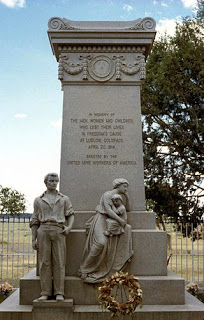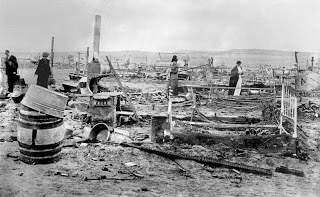Anniversary: The Ludlow Massacre and the Colorado Coalfield War.
The conflict had begun the previous September. About 11,000 miners in southern Colorado went on strike against the powerful Colorado Fuel & Iron Corporation (CF&I) to protest low pay, dangerous working conditions, and the company’s autocratic dominance over the workers’ lives. The CF&I, which was owned by the Rockefeller family and Standard Oil, responded to the strike by immediately evicting the miners and their families from company-owned shacks. With help from the United Mine Workers, the miners moved with their families to canvas tent colonies scattered around the nearby hills and continued to strike.
When the evictions failed to end the strike, the Rockefeller interests hired private detectives that attacked the tent colonies with rifles and Gatling guns. The miners fought back, and several were killed. When the tenacity of the strikers became apparent, the Rockefellers approached the governor of Colorado, who authorized the use of the National Guard. The Rockefellers agreed to pay their wages.
At first, the strikers believed that the government had sent the National Guard to protect them. They soon discovered, though, that the militia was under orders to break the strike. On this day in 1914, two companies of guardsmen attacked the largest tent colony of strikers near the town of Ludlow, home to about 1,000 men, women, and children. The attack began in the morning with a barrage of bullets fired into the tents. The miners shot back with pistols and rifles. -- This Day In History, 20 April.

As I drove yesterday morning down out of Colorado at dawn I passed by the site just off I-25 of the Ludlow massacre. It was the 101st anniversary of the event.
On the morning of April 20, the day after the Orthodox Easter was celebrated in the tent colony, three Guardsmen appeared at the camp ordering the release of a man they claimed was being held against his will. This request prompted the camp leader, Louis Tikas, to meet with a local militia commander at the train station in Ludlow village, a half mile from the colony. While this meeting was progressing, two companies of militia installed a machine gun on a ridge near the camp and took a position along a rail route about half a mile south of Ludlow. Anticipating trouble, Tikas ran back to the camp. The miners, fearing for the safety of their families, set out to flank the militia positions. A gunfight soon broke out.
The fighting raged for the entire day. The militia was reinforced by non-uniformed mine guards later in the afternoon. At dusk, a passing freight train stopped on the tracks in front of the Guards' machine gun placements, allowing many of the miners and their families to escape to an outcrop of hills to the east called the "Black Hills." By 7:00 p.m., the camp was in flames, and the militia descended on it and began to search and loot the camp. Louis Tikas had remained in the camp the entire day and was still there when the fire started. Tikas and two other men were captured by the militia. Tikas and Lt. Karl Linderfelt, commander of one of two Guard companies, had confronted each other several times in the previous months. While two militiamen held Tikas, Linderfelt broke a rifle butt over his head. Tikas and the other two captured miners were later found shot dead. Tikas had been shot in the back. Their bodies lay along the Colorado and Southern Railway tracks for three days in full view of passing trains. The militia officers refused to allow them to be moved until a local of a railway union demanded the bodies be taken away for burial.
During the battle, four women and eleven children had been hiding in a pit beneath one tent, where they were trapped when the tent above them was set on fire. Two of the women and all of the children suffocated. These deaths became a rallying cry for the UMWA, who called the incident the "Ludlow Massacre."
In addition to the fire victims, Louis Tikas and the other men who were shot to death, three company guards and one militiaman were killed in the day's fighting.
In response to the Ludlow massacre, the leaders of organized labor in Colorado issued a call to arms, urging union members to acquire "all the arms and ammunition legally available," and a large-scale guerrilla war ensued, lasting ten days. In Trinidad, Colorado, UMWA officials openly distributed arms and ammunition to strikers at union headquarters. 700 to 1,000 strikers "attacked mine after mine, driving off or killing the guards and setting fire to the buildings." At least fifty people, including those at Ludlow, were killed in ten days of fighting against mine guards and hundreds of militia reinforcements rushed back into the strike zone. The fighting ended only when US President Woodrow Wilson sent in Federal troops. The troops, who reported directly to Washington, DC, disarmed both sides, displacing and often arresting the militia in the process.
The conflict, called the Colorado Coalfield War, produced a death toll of approximately 75 people.



4 comments:
a while back, when we had large gatherings in Albany NY protesting the (so-called) SAFE Act, the only union that stood with us was the United Mine Workers. They understand the importance of an armed citizenry. At the time rumors swirled that another union was going to hold a counter-rally; the collectivist minions SEIU. They never showed, probably due to the fact that the mine workers were there.
I don't know if this is an urban myth, but supposedely, the term "red neck" comes when some of the miners (I think in West Virgina or PA) wore red neck scrafs in order to secretely identify themselves as supporative to a union. This of course led to machine gunning, bombs, etc. So maybe the elite wanted to be sure to demonize the term red neck as a stupid southerner so no one would learn the true history of the real red necks, whom to the liberals dismay helped to support unions when unions were wroth a damn.
The folks in Hardin County, KY, Matewan, WV, and the Pennsylvania coalfields went through something very much like the CO coalfield war. Lot of that went around.
I stopped by that memorial a few years ago. The location looks barren and silent. The plaque there describes in cold historical language what must have been utterly horrific.
Post a Comment